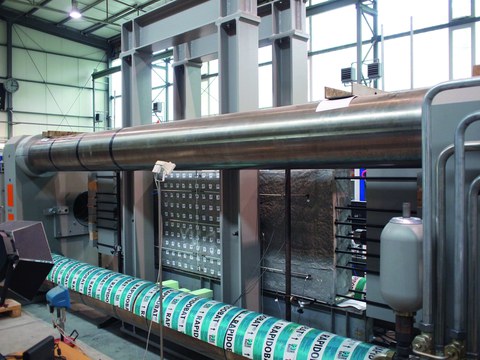Examination of highly ductile concrete for development of constructional elements for bridge construction
Table of contents
Project data
| Titel | Title Untersuchung von hochduktilem Beton für die Entwicklung von konstruktiven Brückenelementen | Examination of highly ductile concrete for development of constructional elements for bridge construction Förderer | Funding Arbeitsgemeinschaft industrieller Forschungsvereinigungen “Otto von Guericke“ e. V. (AiF) Zeitraum | Period 10.2011 – 02.2014 Leiter | Project Manager Prof. Dr.-Ing. Viktor Mechtcherine Bearbeiter | Contributors Dipl.-Ing. Eric Mündecke |
Report in the yearbook 2012
High ductile concrete with reinforcement

Test setup of the uniaxial tensile tests
Under the direction of Prof. Dr.-Ing. Viktor Mechtcherine, the Institute for Building Materials is researching the influence of steel bar reinforcement on the load-bearing behavior of short-fiber-reinforced high-ductility concrete. The research project aims to develop structural elements made of high-ductility concrete for use in bridge construction. In addition, a suitable manufacturing technology must be found. The bridge elements are to be used as an alternative for bridging structural joints, between individual superstructure components or in the transition between superstructure and substructure.
In order to realize the desired project objective, the concrete formulation, the manufacturing technology and the design of the components must be brought into line with the requirements for transition structures. The starting point will be tests at the material and component level, which will be used to determine the decisive parameters for technical development. On this basis, the design and manufacture of the elements are made possible.
In addition to material tests to determine the effect of the fibers on the building material properties, pull-out tests are carried out on steel-reinforced pull-out bodies and centric tensile tests on steel-reinforced expansion bodies. The latter component tests were performed at the Otto Mohr Laboratory. The parameters to be investigated are the strains of the reinforced component as well as the strains or the stresses in the reinforcing bars and the cracking on the concrete surface.
Plate-shaped test specimens with external dimensions of 3.00 × 1.00 × 0.24 m and a two-layer reinforcement were fabricated for the investigations. The welded reinforcement cages were prepared at a company in Großrückerswalde and transported to a Chemnitz mixing plant for production. After concreting and subsequent curing, the slabs weighing approx. 2 t were transported to the Otto Mohr laboratory, where the measuring equipment was then installed. After installation of the slabs in the 10 MN test frame, the slabs were loaded at a loading rate of 0.01 mm/s until failure. The total deformations on the component surface were recorded with a total of 16 inductive displacement transducers as well as an optical 3D measuring system. For the measurement of local deformations, 15 strain gauges applied on the steel reinforcement and an optical 2D measurement on the concrete surface were used.
